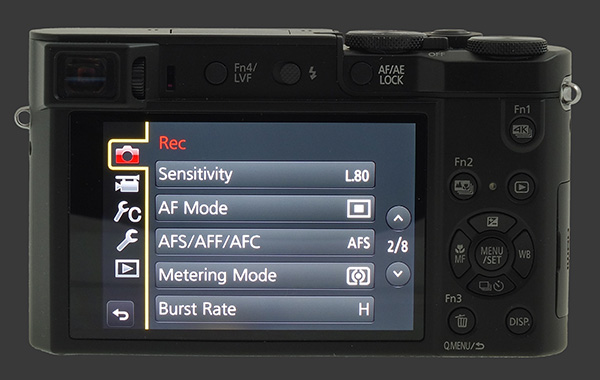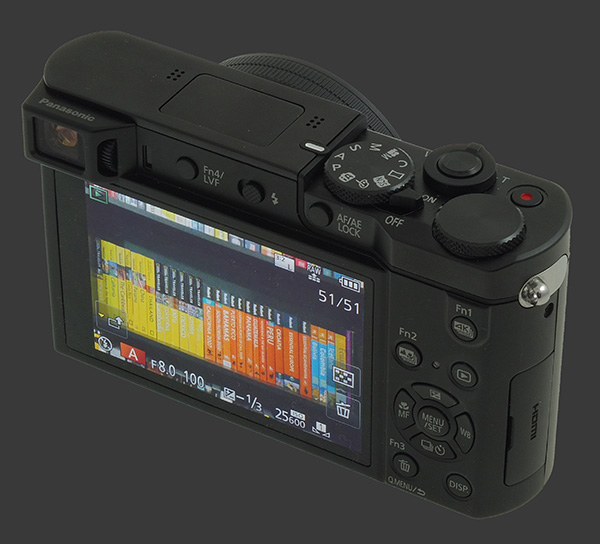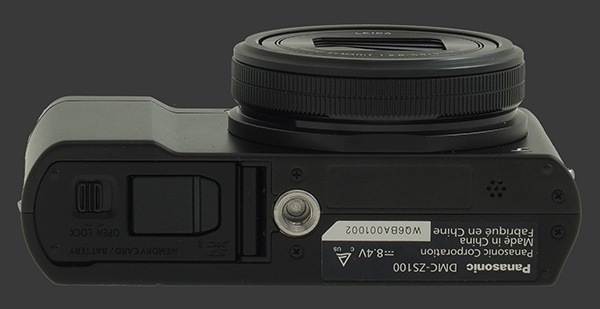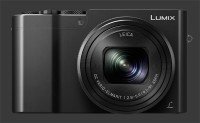Panasonic Lumix DMC-ZS100 Review
Panasonic Lumix DMC-ZS100 Introduction
The Panasonic Lumix DMC-ZS100 is a unique travel-zoom with the largest sensor in its class. Its 20 megapixels 1" CMOS sensor is similar to ones in recent premium compacts and a handful of ultra-zooms but has never been used before to provide both a long reach and compact size. The imaging sensor is paired with a stabilized 10X optical zoom lens, equivalent to a 25-250mm, and having a variable F/2.8-5.9 maximum aperture.
This new Lumix is clearly the first premium travel-zoom given its built-in 116K Pixels 0.2" EVF with Eye-Start sensor, dual control-dials, numerous external controls and an extensive feature-set. The high-speed CMOS sensor can capture full-resolution images at 50 FPS and record Ultra-HD video at 30 FPS or Full HD at 60 FPS. It has a broad ISO 125-12800 sensitivity range, expandable to ISO 80-25600, plus a hybrid shutter which covers shutter-speeds from 1/16000 to 60s.
The ZS100 is packed with features and even manages to pack a built-in flash, a stereo microphone and WiFi. It has a 3" touchscreen LCD with 1 megapixel. While 4K is normally a video-feature, this travel-zoom has it fully integrated with still too. It can capture 4K bursts at 30 FPS with pre-buffering or use it to adjust the focus-plane post-capture.
This camera review covers the usability and performance of the Panasonic Lumix DMC-ZS100.

Panasonic Lumix DMC-ZS100 Features
Sensor & Exposure
- 20 Megapixels 1" CMOS sensor
- 2.7X Crop-Factor, 3:2 Aspect-Ratio
- Native ISO 125 - 12800 sensitivity-range
- Expanded ISO 80, 100 & 25600 sensitivities
- Auto ISO based on light-levels and movement
- 1/2000 - 60s Mechanical shutter-speeds
- 1/16000 - 1s Electronic shutter-speeds
- PASM Exposure modes for both stills and video
- Exposure-Compensation, ±5 in 1/3 EV increments
- Multi-Segment, Center-Weighed and Spot metering modes
Lens
- Wide 25-250mm equivalent 10X optical zoom lens
- F/2.8 - 5.9 Maximum aperture, F/8 Minimum
- 5cm (W) - 70m (T) Normal minimum focus
- 3cm Macro minimum focus
- Optical image stabilization
- Standard or Paning Stabilization
Image Parameters
- Automatic, 5 presetsDaylight, Cloudy, Shade, Flash, Incandescent, Kelvin and custom white-balance, 4 memories
- WB fine-tuning, 19 steps along 2 axis
- White-Balance bracketing, 3 frames, along 2 axis
- Standard, Vivid, Natural, Monochrome, Scenic and Portrait color modes
- Adjustable Contrast, Sharpness, Saturation and Noise-Reduction 11 steps each
- Adjustable Highlights Tone and Shadow Tone, 11 steps each, 3 memories
- White-Balance Bracketing, 3 frames, 3 steps sizes along one of two axis
- Native 3:2, plus 4:3, 16:9 and 1:1 Aspect-Ratios
- JPEG, RAW or RAW+JPEG output
- Optional Long-Shutter Noise-Reduction
- Optional Tone-Enhancement, 3 levels or Auto
- Optional Resolution-Enhancement, 4 levels
- Optional Diffraction Compensation
Drive
- 50 FPS Drive, AF-S, Max 60 Frames
- 10 FPS Drive, AF-C, Max 35 Frames
- 6 FPS Drive, AF-C with Live-View, Unlimited
- 4K Burst, 30 FPS, 60 Frames, Half pre-buffered
- Post-Focus 4K Capture
- Self-Timer: 2s, 10s or 3 shots @ 10s
- Exposure Bracketing, 7 frames, 1/3-1 EV steps
- Multiple-Exposure: Maximum 3 frames, optional Auto-Gain
- Time Lapse: 1s - 100m interval, 1 - 9999 frames
- Stop Motion: Manual Advance Time-Lapse
- Aspect Ratio Virtual Bracket, always 4 frames
- Builtin HDR capture
Focus
- Normal, Macro, Manual and DMF Focus-Modes
- Pinpoint, Single Area, Multi-Area, Auto, Tracking and Face-Detect focus-selection
- Quick and Eye-Start Sensor Prefocus
- Optional Manual Focus assist
- Optional Focus Peeking
- Optional AF Assist-Lamp
Display & Viewfinder
- 3" Touchscreen LCD, 1 Megapixel
- 0.2" EVF, 116K Pixels, 0.46X Magnification
- Eye-Start Sensor, 2 sensitivities
- Adjustable Brightness, Contrast, Saturation, 13 steps each
- Adjustable Red-Tint and Blue-Tint, 21 steps each
- Optional Guidelines, Zebra Pattern and Highlight display
- Optional Exposure-Priority display in Manual mode
Video
- 3840x2160 Ultra-HD 4K @ 24 or 30 FPS
- 1920x1080 Full HD 1080p @ 60 FPS
- MPEG-4: 4K 100 Mbps and 1080p 28 Mbps
- AVCHD: 1080p, 1080i and 720p
- AF-S or AF-C Focus-Mode
- 4K Live Cropping mode
- Optional Wind-Filter, 2 levels
- Optional Zoom Microphone
- Optional Level Shot, 1080p or 720p
Flash
- Flash-Compensation, ±2 in 1/3 EV increments
- Forced, Redeye, Slow-Sync, Redeye & Slow-Sync modes
- First or Rear curtain flash sync
- Optional redeye removal
Connectivity
- 4K HDMI output
- USB 2.0 connectivity
- Built-in WiFi, 802.11n
Misc
- Stepless Lens Control-Ring
- Top-Plate Control-Dial
- Combined AE-L/AF-L button
- 4 Customizable buttons
- Sweep Panorama mode
- 24 Scene-Modes
- Optional Face Recognition
- Lithium-Ion battery
- SDXC memory
Reviewed using a pre-production version of the Panasonic Lumix DMC-ZS100. The final version may exhibit slightly different behavior and performance as described here.
Panasonic Lumix DMC-ZS100 Usability - How easy is it to use?
The Panasonic Lumix DMC-ZS100 is a compact digital camera with a protruding lens barrel and plenty of external controls. The front provides a small grip on a smooth surface. Given that the lens is surrounded by a control-ring which acts as one of the control-dials, the ZS100 invites two-handed holding. Eyelets on both sides allow for a neck-strap but the provided wrist-strap is quite sufficient considering the light weight of this digital camera.
The lens barrel extends ¾" from the front plate. When on, the lens extends up to 3" further, depending on the zoom position. The lens itself is self-closing, so no cap is required. A nice control-ring around the lens barrel rotates smoothly. It can be configured to control continuous or discrete settings, including any exposure parameter. When manual focus is available, the control-ring sets the focus-distance. Since there are no click-stops, this ring can easily be rotated inadvertently.

Looking from the top, one can see the popup flash door, framed by a pair of microphone to record stereo sound. The top-plate is split so that controls align with the top of the camera. There is a standard mode-dial with 10 positions and strong detents. The standard PASM modes are all there, plus Movie, Custom, Panorama, Scene, Filter and a fully automatic mode. While movies can be recording in any mode, the dedicated Movie mode lets the camera be ready and show the proper framing for video.
There is a small shutter-release with moderate travel and a soft halfway point. This makes it easy to take a shot without introducing much camera shake, while it also reduces chances of accidentally triggering. A standard rotating zoom controller surrounds the release. It normally zooms in fine steps through the entire 10X optical zoom range in 3 seconds. Alternately, the lens control-ring can also be used to zoom. Both zoom controls can optionally jump in 11 fixed steps to mimic a set of typical prime lens focal-lengths.
A small Video Record button appears flush with the top plate at the front-right corner of the camera. It initiates video capture in all modes yet is entirely redundant considering that the shutter-release does the same thing in Video mode. It would have been nice if it were customizable to activate a common function such as Exposure-Compensation.
A control-dial is the last control on the top-plate. It has good detents with nice positive action. Oddly, the first click is usually ignored, so to increment a parameter by one step, the control-dial must be turned two clicks. This might be a bug on this pre-production unit. This control-dial can change one of 15 parameters. Most usefully, this can be ISO. EC is another highly probable option as its control, described further down in this review page, is slightly awkward.
Dual control-dials are put to excellent use on the Panasonic ZS100. By default, both control dials control the same parameter except in Manual mode where one sets aperture and the other shutter-speed. Unless one shoots mostly in Manual mode, this is quite redundant. Fortunately, both dials can be configured separately. When one is set to Default, it controls the exposure parameter or alternates between two with the press of Up on the 4-way controller. The other dial can then be set to continuously zoom, discretely zoom, apply exposure-compensation, change ISO sensitivity, cycle over White-Balance options, change the focus mode or drive, set the drive mode, change photo style, apply filters, set the aspect-ratio, change tone curves, control dynamic-range adjustment, toggle resolution enhancement, cycle over flash modes or apply flash-compensation. ISO or EC are the top-choices here and make the camera efficient to control.

Everything else happens on the back of the Panasonic Lumix DMC-ZS100 which is dominated by a 3" LCD with 1 megapixel. The display is a touchscreen which can be disabled. Since the camera is rather small, it is extremely easy to brush the touchscreen and inadvertently move the focus-point, as it happened often during the review. Touch is configurable so that it is possible to disable AF and the Touch Tab but still navigate menus and image playback by touch.
The screen is sharp and easily visible outdoors. It has an effective anti-reflective coating and a good viewing angle. The display is incredibly adjustable with separate controls for Brightness, Contrast, Color, Red and Blue, plus 3 general brightness levels. This implies that it is not Exposure-Priority except, optionally, in Manual mode. As such the preview is not usually reliable. Our pre-production review unit has some backlight leaking near the bottom edge but we do not expect this to be a problem with a final ZS100.
A tiny 0.2" EVF with 116K pixels is found at the upper left corner of the Panasonic ZS100. This is obviously a small and low-resolution unit but travel-zooms rarely have a viewfinder at all. It is useful for framing in bright light and improves stability yet is not sufficiently sharp to confirm focus or inspect fine details. Panasonic even squeezed an extremely useful Eye-Start Sensor next to the EVF, so that the ZS100 can switch automatically between the EVF and LCD.
Next to the Eye-Start Sensor, there is a small round button which cycles between Auto, EVF or LCD displays. Considering that the ZS100 switches perfectly between the viewfinder and display, this button can be reconfigured to one of 51 functions! These same options are available for all 4 Function buttons. There also 5 virtual function buttons on the touchscreen. Those can activate one of 35 functions which is still very impressive.

There is a spring-loaded flash-release latch to the right of the Fn4/LVF button. Since the latch is mechanical, it can popup the flash when the camera is powered off. However, the camera will refuse to shutdown if the popup flash is raised. The combined AF-L/AE-L button is also found along the upper edge of the LCD.
To the right of the LCD, there are 5 more buttons in additional to a 4-way controller with a central button. Three of these buttons are customizable. The other two are Playback and Disp. Both these work as expected. Playback enters and exits Playback mode, while Disp cycles over various display modes. The camera is Shooting-Priority but will not power directly into Playback mode.
One of the function buttons, double as Delete during playback, so one cannot instantly quickly delete an image during Instant Review or in Capture mode. By default, this one activates a Quick Menu which provides yet another level of customization.
Between the independent buttons, there is a 4-way controller made of 5 separate buttons including the central OK. The controller is used to navigate menus and activate important functions:
- Up: Activates Exposure-Compensation for change by the upper control-dial or Left and Right buttons. EC can be set from -5 to +5 in 1/3 EV increments. Pressing Up again, returns to normal.
- Right: Selects White-Balance, including Kelvin temperature and two Custom WB memories. Both WB Fine-Tuning and Bracketing are accessible from there.
- Down: Selects the Drive mode, including Single-Shot, Continuous Shooting with four sub-options, 4K Photo, AEB and Self-Timers. There is one 2s Self-Timer and two 10s ones, one which takes a single shot and the other that takes three.
- Left: Cycles over AF, Macro, Digital Zoom Macro and MF modes. The focus selection mode and focus area must be configured elsewhere.
A neat trick of the Panasonic ZS100 is its Post Shot Focus function which allows to focus on one of 49 focus areas after a shot it taken. What it does is simply record a short nearly 4K video where each area is in focus. It then presents an interface where the user selects a focus area with the 4-way controller or touchscreen and presses OK to save the frame with that area in focus. The result is an 8 megapixels image with a 3:2 aspect-ratio which gives 3504x2336 pixels. The limitation of this feature is that it uses a 1.48X crop-area which makes the lens equivalent to 37-370mm. During area selection, Fn2 toggles Focus Peaking so that the sharpest edges get highlighted.

The bottom of the ZS100 has a metal tripod mount which is not inline with the optical center of the lens. It has a relatively sturdy door covering a combined battery and memory card compartment. This digital camera charges a proprietary Lithium-Ion battery internally which unfortunately prevents using the camera while charging. A card slots accepts SDXC cards which must be sufficiently fast to record 4K Ultra-HD video. Otherwise, the camera stops recording early with a helpful message notifying the user of the issue.
The Panasonic ZS100 feels solid with a confidence-inspiring weight. It is well put together with all buttons and dials providing good tactile feedback. Only the control-ring rotates smoothly. The interface is generally pleasant to use and efficient. The default changing of EC though is not great since it requires a press to activate and another to exit. What is fantastic about the ZS100 is its level of customization which lets all important functions be readily accessible.
 |
Please Support Neocamera
All information on Neocamera is provided free of charge yet running this website is a huge endeavor. Purchases made via affiliate links found throughout the site help keep it running and up-to-date. There is no additional cost to you, so please consider buying via these links to our affilates:
If you found any information on this site valuable and did not purchase via our affiliate links, please considering donating via PayPal:
Any amount will be greatly appreaciated. Thank you for your support!
Panasonic DMC-ZS100 Highlights

Sensor-Size: 13 x 9mm

Actual size when viewed at 100 DPI
| 20 Megapixels Travel Zoom | ISO 125-12800 |
| 10X Ultra-Wide Optical Zoom | Shutter 1/16000-60s |
| Built-in Stabilization | Full manual controls, including Manual Focus |
| 0.20" Built-in EVF 120K Pixels (0.46X) | Custom white-balance with 2 axis fine-tuning |
| Automatic Eye-Start sensor | Spot-Metering |
| Auto Horizon Correction 2 Axis Digital Level | Lithium-Ion Battery |
| 50 FPS Drive, Unlimited Images | Secure Digital Extended Capacity |
| 3840x2160 @ 30 FPS Video Recording | |
| 3" LCD 1 Megapixels |
Updates
2024.11.18

Best 2024 Photography Gifts for Every Budget
Great gifts for photographers and photo enthusiasts selected for every budget among the best products of 2024.
2024.08.07

Eye Protection Tips for Professional Photographers
The four main considerations for professional photographers regarding eyewear.
2024.07.14

Fujifilm X100VI Review
Flagship fixed-lens compact digital camera with a 40 MP sensor and Image-Stabilization, a first for the series. Retro design featuring dual control-dials, plus direct ISO, Shutter-Speed and EC dials. Its hybrid viewfinder can switch between EVF and OVF mode.
2024.05.09

Fujifilm GFX100 II Review
Flagship 102 Megapixels Medium-Format Mirrorless Digital Camera with 8-Stop 5-Axis IBIS, 8 FPS Drive, 8K Video and 400 MP Super-Resolution capture in a weatherproof and freezeproof body with dual control-dials and dual memory-card slots.
2024.04.03

Fujifilm X-T5 Review
Newest Fujifilm flagship boasting a 40 MP APS-C sensor, 5-axis IBIS with 7-stop efficiency, 15 FPS continuous drive, 6.2K Video capture, dual control-dials and dual SDXC UHS-II slots in a sturdy weatherproof and freezeproof body.
2023.11.20

Best Digital Cameras of 2023
Find out which are the Best Digital Cameras of 2023. All the new Mirrorless Digital Cameras from entry-level to high-end professional.
2023.07.10

Fujifilm X-H2 Review
40 Megapixels APS-C Hybrid Mirrorless Digital Camera with 7-stop IBIS. Fastest shutter ever and 8K video capture. Large builtin EVF with 0.8X magnification and 5.8 MP, plus an Eye-Start Sensor. Packed with features and large number of controls in a weatherproof and freezeproof body.
2023.05.07

Sony FE 20-70mm F/4G Review
Review of the unique Sony FE 20-70mm F/4G lens. The optical zoom of this lens spans ultra-wide-angle and medium focal-length coverage, making it one of the most versatile Full-Frame lenses on the market.
2023.01.15

Huion Inspiroy Dial 2 Review
Review of the Huion Inspiroy Dial 2 tablet, a medium sized drawing surface with dual dials and customizable buttons. Connects via USB-C or Bluetooth 5.0 with Windows, Linux and Android support.
2022.12.08

How to Pack for a Photo Trip
Find out how to pack for a travel photography trip, carry your gear safely while meeting airline regulations.
2022.11.13

Best Digital Cameras of 2022
The best digital cameras of 2022. A short list of the most outstanding models in their respective categories. Choose one for yourself or as a gift.
2022.09.21

Pentax DA* 60-250mm F/4 SDM Review
Review of the Pentax DA* 60-250mm F/4 SDM, the constant-aperture telephoto zoom with the highest zoom-ratio on the market.














